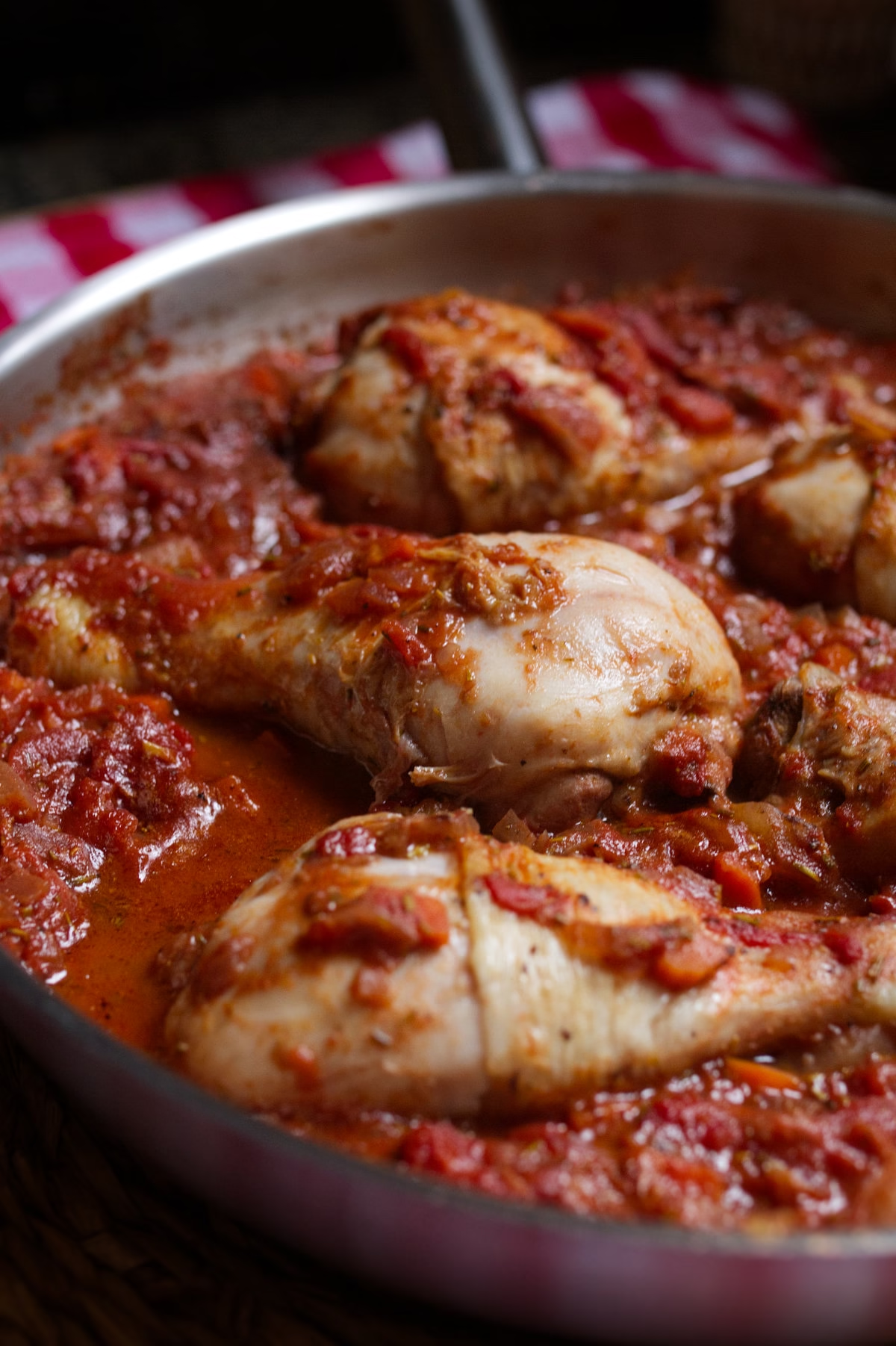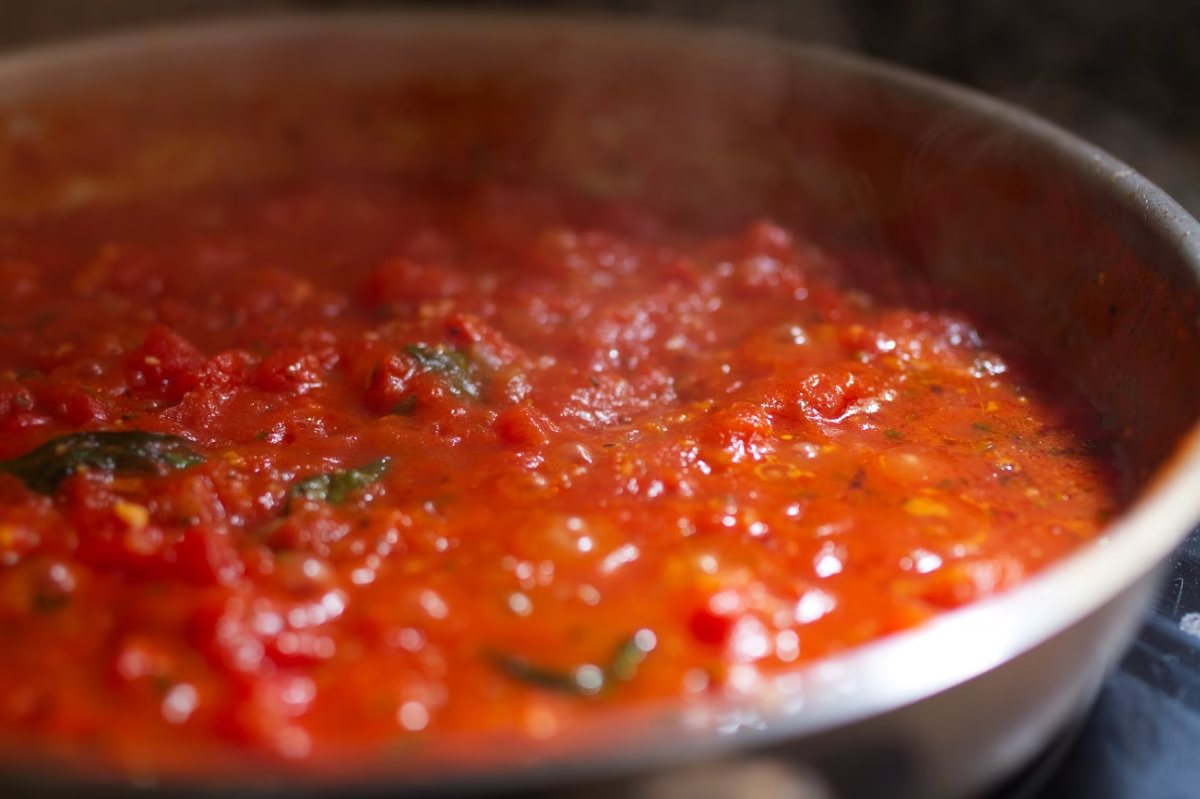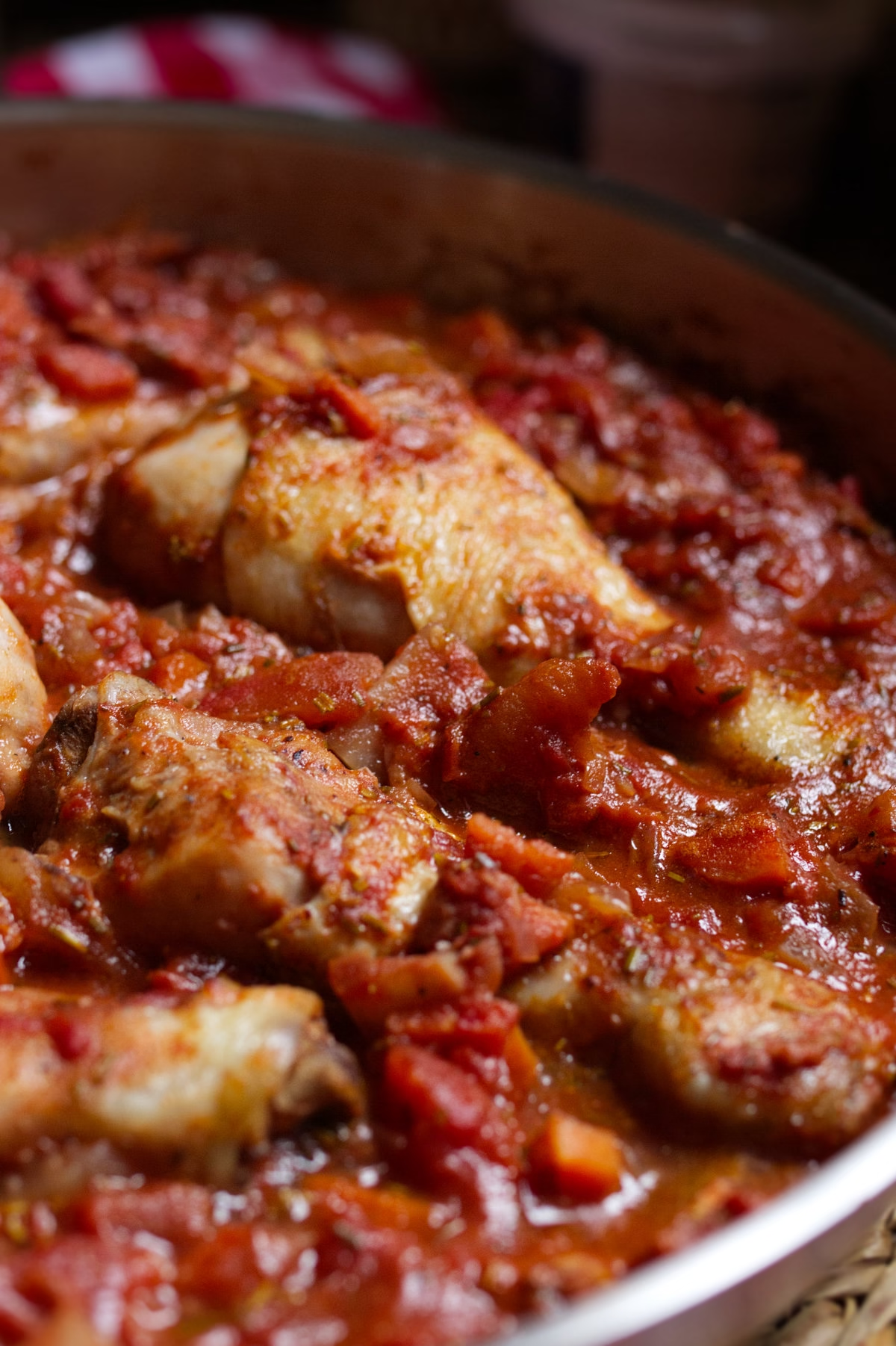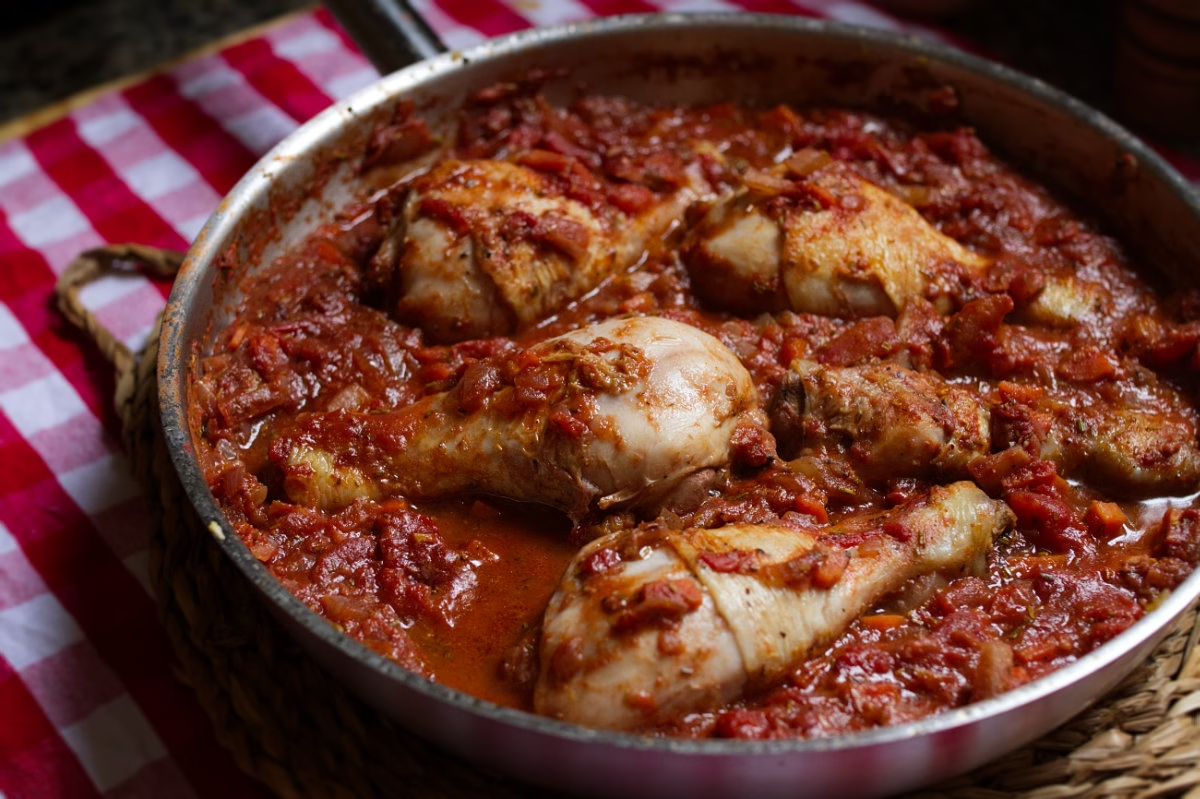Pollo alla Cacciatora, Traditional Hunter’s Chicken is a classic Italian dish that captures the heart of rustic countryside cooking. Tender chicken pieces are braised slowly with wine, tomatoes, and fragrant herbs to create a rich, comforting stew that tells the story of cucina povera — Italy’s humble yet deeply flavorful “peasant cuisine.”
Imagine the scene: a Tuscan farmhouse, the scent of rosemary and wine filling the air. Hunters return from the fields, and with just a few humble ingredients — olive oil, tomatoes, herbs, and a good splash of vino — dinner begins to take shape.
Whether you use white wine for a Tuscan touch or red for a heartier Umbrian style, this authentic Pollo alla Cacciatora recipe brings the warmth and simplicity of traditional Italian home cooking straight to your table.
Italian | Main | Chicken | Tomatoes | Sauce
Table of contents:
- How to Make Pollo alla Cacciatora – Traditional Hunter’s Chicken
- Traditional (and delicious) ways Italians thicken the sauce
- 🇮🇹 Cucina Povera – The Soul of Italian Home Cooking
- Tomatoes to use for Cacciatora Sauce
- FAQs – Pollo alla Cacciatora

How to Make Pollo alla Cacciatora – Traditional Hunter’s Chicken
Ingredients
- 35oz. (1 kg) chicken pieces (drumsticks, thighs, skin on)
- Extra Virgin Olive Oil
- 1 medium onion, finely diced
- 1 carrot, finely chopped
- ½ cup fennel, finely chopped (or 1-2 celery stalks)
- 6 cloves garlic, minced (optional)
- 100 ml dry white or red wine (either is authentic — white is more Tuscan, red is more Umbrian)
- 14oz. (400g) whole Tomatoes (canned)
- 1 Tbsp Dried Rosemary
- Salt and black pepper, to taste
Equipment
- 1 large Skillet or pan
- Wooden spatula
- Chef Knife
- Wooden Cutting Board
- Cooking tongs
- Garlic Press

Instructions
- Brown the chicken:
Heat the olive oil in a large heavy pan. Add the chicken pieces and brown them well on all sides. Remove and set aside. - Make the soffritto:
In the same pan, add onion, carrot, fennel, and garlic (if using). Sauté gently for 5–7 minutes until soft and fragrant. - Deglaze:
Pour in the wine, stirring to dissolve any browned bits. Let it bubble for 2–3 minutes until slightly reduced. - Add tomatoes and herbs:
Stir in the chopped tomatoes and rosemary. Season with salt and pepper to taste. - Simmer:
Return the chicken to the pan and cover with sauce. Cover and simmer on low heat for 45–60 minutes, turning the chicken around halfway through. If it starts to dry out, add a splash of water or stock.
To serve
Serve with crusty bread, or some mashed potatoes — something to soak up the rich sauce.

Traditional (and delicious) ways Italians thicken the sauce
If your goal is a richer, thicker cacciatora sauce, here are authentic methods:
- Soffritto reduction
Let the onion, carrot, and celery (or fennel) cook very slowly until almost jammy — they naturally thicken the sauce. - Tomato concentration
Use a few spoonfuls of tomato paste (concentrato di pomodoro) early in cooking, and simmer uncovered at the end to reduce. - Blended vegetables
Before serving, you can blend part of the sauce (with the veggies, not the skin!) to make it smoother and more velvety.
Flour dusting (non-traditional but effective)
Lightly dust the chicken with flour before browning — this helps the sauce thicken naturally as it cooks.
More Italian Sauce Recipes:

Origin of Pollo alla Cacciatora
Pollo alla Cacciatora — literally “hunter’s-style chicken” — is one of Italy’s most beloved rustic dishes, born from the traditions of the countryside rather than the kitchens of the nobility. The word cacciatora (from cacciatore, meaning “hunter”) refers not to a particular region, but to a style of cooking used throughout central and northern Italy.
Historically, this dish evolved as a peasant or farmhouse meal, prepared after a successful hunt. Hunters would cook what they had available — often wild fowl or rabbit — together with simple ingredients carried or found along the way: garlic, herbs like rosemary or sage, a splash of wine, and sometimes a few preserved tomatoes. There was no strict recipe; each household or village adapted it according to local produce and traditions.
Over time, as chicken became more common than game, pollo alla cacciatora replaced wild birds and became a Sunday family dish, especially in Tuscany, Umbria, and Emilia-Romagna. In Tuscany, it’s often made in bianco (without tomato), using white wine and herbs for a delicate, aromatic flavor. Further south, particularly around Rome and Naples, tomato and sometimes olives or capers are added, giving the dish its richer, red sauce.
What unites all versions is their simplicity and depth of flavor — a slow-cooked stew that captures the essence of rural Italian cooking: honest, resourceful, and deeply comforting. Each spoonful tells the story of a time when meals were made from what the land (and sometimes the hunt) could provide.

🇮🇹 Cucina Povera – The Soul of Italian Home Cooking
In Italy, “peasant cooking” is generally known as cucina povera — literally, “the cuisine of the poor.”
Cucina povera isn’t just about poverty — it’s about resourcefulness, simplicity, and respect for ingredients.
It emerged from centuries of rural life, when families made the most of whatever they had: humble grains, beans, seasonal vegetables, foraged herbs, and small amounts of meat or cheese.
Key traits include:
- Using every part of an ingredient — bones, skins, stale bread, or leftover pasta.
- Cooking slowly and simply to coax out deep flavor.
- Relying on local, seasonal produce and pantry staples like olive oil, garlic, and preserved tomatoes.
- Creating dishes that are nutritious, satisfying, and comforting without extravagance.
🍞 Examples of Cucina Povera
Some of Italy’s most iconic dishes come from this tradition:
- Ribollita (Tuscan bread and vegetable soup)
- Pasta e fagioli (pasta and beans)
- Panzanella (stale bread salad)
- Polenta con funghi (cornmeal with mushrooms)
Pollo alla Cacciatora — a perfect example: chicken braised slowly with wine, herbs, and simple aromatics.
Tomatoes to use for Cacciatora Sauce
The tomatoes are the backbone of the sauce—so the variety really matters. If there’s one ingredient to spend some time hunting down, it’s some good quality tomatoes. Italians reach for San Marzano tomatoes, prized for their naturally sweet flavor, low acidity, and meaty texture.
Here are the best options:
Cento Certified San Marzano Whole Peeled Tomatoes, 28 Oz (Pack of 6)
Muir Glen Organic Diced Canned Tomatoes, 28 oz.
Mutti Whole Peeled Tomatoes (Pelati), 28 oz. | 6 Pack
Crushed tomatoes (shortcut): A convenient option if you want a smoother sauce without blending whole tomatoes yourself.
San Marzano (best choice): Grown in Italy’s Campania region, these tomatoes are D.O.P.-certified and considered the gold standard. They break down into a silky, balanced sauce.

Nutrition Facts – Pollo alla Cacciatora (Per Serving)
| Nutrient | Amount per serving | % Daily Value (DV) |
| Calories | 395 kcal | 20% |
| Total Fat | 23 g | 29% |
| • Saturated Fat | 5 g | 25% |
| • Monounsaturated Fat | 13 g | — |
| Cholesterol | 115 mg | 38% |
| Sodium | 480 mg | 21% |
| Total Carbohydrates | 10 g | 4% |
| • Dietary Fiber | 2 g | 7% |
| • Total Sugars | 4 g | — |
| Protein | 36 g | 72% |
| Vitamin A | — | 35% |
| Vitamin C | — | 20% |
| Calcium | — | 5% |
| Iron | — | 10% |
| Potassium | — | 18% |
💡 Notes:
- Using skinless chicken reduces fat and calories by ~20%.
- Using red wine instead of white adds slightly more antioxidants and a deeper flavor.
- Serve with crusty bread or polenta

Pollo alla Cacciatora – Traditional Hunter’s Chicken
Equipment
- 1 Large skillet or pan
- Wooden spatula
- Chef Knife
- Wooden Cutting Board
- Cooking tongs
- Garlic press
Ingredients
- 35 oz. 1 kg chicken pieces (drumsticks, thighs, skin on)
- Extra Virgin Olive Oil
- 1 medium onion finely diced
- 1 carrot finely chopped
- ½ cup fennel finely chopped (or 1-2 celery stalks)
- 6 cloves garlic minced (optional)
- 100 ml dry white or red wine either is authentic — white is more Tuscan, red is more Umbrian
- 14 oz. 400g whole Tomatoes (canned)
- 1 Tbsp Dried Rosemary
- Salt and black pepper to taste
Instructions
Brown the chicken:
- Heat the olive oil in a large heavy pan. Add the chicken pieces and brown them well on all sides. Remove and set aside.Extra Virgin Olive Oil, 35 oz. 1 kg chicken pieces (drumsticks, thighs, skin on)
Make the soffritto:
- In the same pan, add onion, carrot, fennel, and garlic (if using). Sauté gently for 5–7 minutes until soft and fragrant.1 medium onion, 1 carrot, ½ cup fennel, 6 cloves garlic
Deglaze:
- Add tomatoes and herbs:14 oz. 400g whole Tomatoes (canned)
- Pour in the wine, stirring to dissolve any browned bits. Let it bubble for 10 minutes until slightly reduced.100 ml dry white or red wine
- Season with salt and pepper to taste.1 Tbsp Dried Rosemary, Salt and black pepper
Simmer:
- Return the chicken to the pan.
- Cover and simmer on low heat for 45–60 minutes, turning the chicken around halfway through. If it starts to dry out, add a splash of water or stock.
To serve
- Serve with crusty bread, or some mashed potatoes — something to soak up the rich sauce.
Video
Notes
Traditional (and delicious) ways Italians thicken the sauce
If your goal is a richer, thicker cacciatora sauce, here are authentic methods:- Soffritto reduction
Let the onion, carrot, and celery (or fennel) cook very slowly until almost jammy — they naturally thicken the sauce. - Tomato concentration
Use a few spoonfuls of tomato paste (concentrato di pomodoro) early in cooking, and simmer uncovered at the end to reduce. - Blended vegetables
Before serving, you can blend part of the sauce (with the veggies, not the skin!) to make it smoother and more velvety.
Lightly dust the chicken with flour before browning — this helps the sauce thicken naturally as it cooks.
FAQs – Pollo alla Cacciatora
1. What does Pollo alla Cacciatora mean?
“Pollo alla Cacciatora” literally means “hunter’s-style chicken” in Italian. It refers to a rustic way of cooking chicken with wine, herbs, and vegetables — a traditional countryside dish.
2. What’s the difference between white wine and red wine versions?
Both are authentic! The Tuscan version typically uses white wine and no tomato for a lighter flavor, while the Umbrian and Roman versions use red wine and tomatoes for a richer, deeper sauce.
3. Can I make Pollo alla Cacciatora ahead of time?
Absolutely. This dish actually tastes better the next day as the flavors meld together. Simply reheat gently on the stove or in the oven.
4. What can I serve with Pollo alla Cacciatora?
Traditional sides include crusty Italian bread, polenta, mashed potatoes, or buttered pasta — anything that can soak up the flavorful sauce.
5. Is Pollo alla Cacciatora healthy?
Yes! It’s a balanced, high-protein dish made with lean chicken, olive oil, and vegetables. Using skinless chicken or less oil can reduce calories and fat.
6. Can I make Pollo alla Cacciatora without wine?
Yes — substitute the wine with chicken broth and a splash of balsamic vinegar or lemon juice to keep that subtle tang and depth of flavor.

